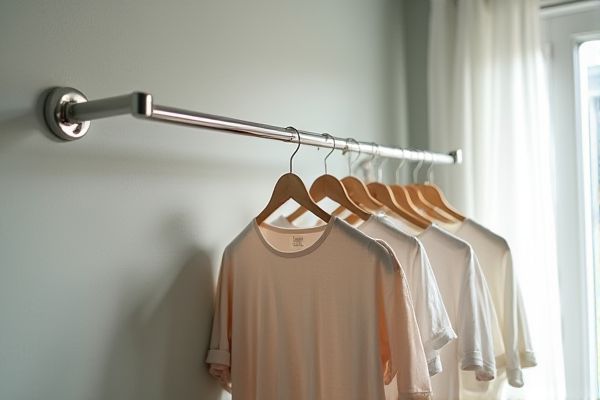
Overhead drying rods save floor space by utilizing ceiling areas, making them ideal for small rooms, while wall drying rods are mounted at eye level for easy access and better ventilation. Discover which option suits Your needs best by exploring the full comparison in the rest of the article.
Table of Comparison
| Feature | Overhead Drying Rod | Wall Drying Rod |
|---|---|---|
| Installation Location | Ceiling mounted | Wall mounted |
| Space Efficiency | Utilizes vertical space, ideal for small rooms | Uses horizontal wall space, requires free wall area |
| Drying Capacity | Can hold multiple items, larger capacity | Typically holds fewer items |
| Ease of Access | May require reaching up or using a stool | More accessible at arm's height |
| Installation Complexity | More complex, needs ceiling support | Simple installation on wall studs |
| Durability | Strong support for heavy loads | Depends on wall strength, less heavy-duty |
| Air Circulation | Better air flow, faster drying | Moderate air flow |
| Cost | Typically higher due to installation and materials | Generally lower cost |
Introduction to Overhead and Wall Drying Rods
Overhead drying rods are ceiling-mounted systems that maximize vertical space for hanging clothes, making them ideal for compact areas. Wall drying rods attach directly to walls, offering easy access and efficient use of horizontal space in laundry rooms or balconies. Both types optimize airflow to speed up drying while catering to different spatial configurations and user preferences.
Key Features of Overhead Drying Rods
Overhead drying rods feature space-saving designs that maximize vertical drying capacity, making them ideal for small laundry areas or rooms with limited wall space. These rods often include adjustable heights and retractable mechanisms, allowing you to customize drying length and easily store the rod when not in use. Constructed with durable materials, overhead drying rods promote efficient air circulation by suspending clothes freely, speeding up the drying process compared to traditional wall drying rods.
Key Features of Wall Drying Rods
Wall drying rods are mounted directly onto walls, maximizing space efficiency in laundry areas by utilizing vertical surfaces. These rods often feature extendable designs for adjustable drying lengths and sturdy materials like stainless steel or aluminum to support heavy wet clothes. Their compact installation helps maintain a neat appearance while ensuring optimal airflow for faster drying times.
Space Utilization and Room Suitability
Overhead drying rods maximize vertical space, making them ideal for small rooms or apartments with limited floor area, while wall drying rods optimize horizontal wall space, suitable for narrow or elongated rooms. Overhead rods keep floors clear, enhancing overall space utilization, whereas wall-mounted rods offer easy access for quick drying in kitchens or laundry rooms. Room suitability depends on ceiling height and wall availability, with overhead rods benefiting taller spaces and wall rods fitting well in confined corridors or utility areas.
Installation Process and Requirements
Overhead drying rods require secure ceiling mounts and often involve drilling into joists, making the installation process more complex and demanding sturdy support for weight. Wall drying rods are typically easier to install, needing strong wall anchors or studs to hold the rod securely, which simplifies setup and reduces structural impact. Your choice depends on available space and installation feasibility, with wall rods suitable for smaller areas and overhead rods offering more drying capacity in larger rooms.
Durability and Material Comparisons
Overhead drying rods are typically made from stainless steel or heavy-duty aluminum, providing enhanced durability and resistance to rust, ideal for long-term use in humid environments. Wall drying rods often use lighter materials like plastic or thinner metals, which may compromise strength and longevity under heavy loads. Your choice between overhead and wall drying rods should consider the material quality and durability to ensure optimal performance and lifespan.
Load Capacity and Stability
Overhead drying rods typically offer higher load capacity due to their robust ceiling-mounted design, allowing them to support heavier clothes and larger laundry loads without sagging. Wall drying rods, while often easier to install, may have lower load capacity and require secure anchoring to ensure stability under weight. To maximize Your drying efficiency, consider the type of laundry you'll hang and the strength of the mounting surface when choosing between overhead and wall drying rods.
Ease of Use and Accessibility
Overhead drying rods provide ample drying space and keep clothes elevated, making them ideal for maximizing floor area but may require reaching up high, which can be challenging for shorter individuals. Wall drying rods are installed at accessible heights, offering easier reach and convenience for everyday use, especially in smaller spaces or for those with mobility limitations. Both options enhance drying efficiency, but wall drying rods typically offer superior accessibility and ease of use for frequent loading and unloading.
Design, Aesthetics, and Customization
Overhead drying rods offer a sleek, space-saving design ideal for rooms with high ceilings, providing a modern aesthetic that blends seamlessly into contemporary interiors. Wall drying rods maximize wall space utilization and come in various finishes and styles, allowing you to customize their look to match your room's decor. Both options provide practical drying solutions, but your choice depends on the level of customization and visual impact you desire for your living space.
Cost Comparison and Value for Money
Overhead drying rods generally cost more due to their complex installation and higher material requirements, while wall drying rods offer a more budget-friendly solution with easier setup. Wall drying rods provide excellent value for money by maximizing space efficiency and minimizing installation expenses, making them ideal for smaller areas. Overhead options may deliver greater drying capacity but often require a higher initial investment that may not justify the added benefits for typical household use.
 homyna.com
homyna.com